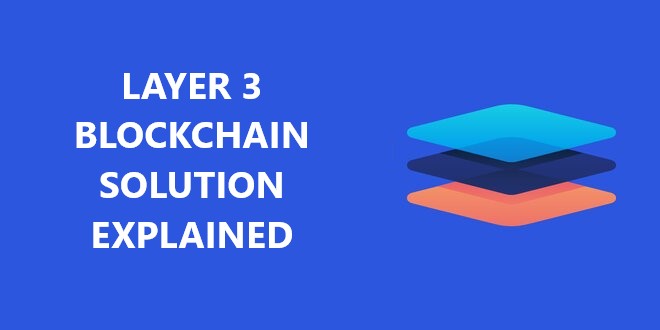Scalability has become an even more stressful issue as the crypto space goes through increased customer demand. Many of us have been accustomed to terms like “layer one” and “layer two” protocols in the blockchains across the globe. Blockchains must be very safe because of the lack of a centralized authority. They must also be highly scalable to cater to the developing transactions and users. Today, we will learn about the Layer 3 blockchain solution, a technology focusing on offering scalability while keeping up with the top-notch security.
A Look Into Multi-Layer Blockchain
If you have spent any time in the crypto space, you have probably heard of the “blockchain trilemma.” Simply stated, present blockchains can only satisfy two of the 3 attributes listed below:
- Decentralization: the exclusion of a centralized system in the system.
- Scalability: the capacity of a blockchain accommodating a larger volume of transactions.
- Security: the capacity of a blockchain to safeguard data from various forms of double-spending or attacks.
As an outcome, all the initiatives of blockchain must sacrifice one space to flourish in the other two. This is a typical trade-off, along with traditional blockchains (ETH or BTC) betting on security and decentralization.
On the contrary, a system like Solana depends on scalability and security with a less decentralized framework. The scalability trilemma only turns into an issue when blockchain systems need all three attributes on their first layer. A system that cannot reach beyond its first layer (or L1) will require sacrificing one of the features.
As a result, the multi-layer structure of blockchains offers a cost-effective solution to the scalability trilemma. Theoretically, a well-designed system can attain security, decentralization, and scalability.
Why Does The Market Require Layer 3 Blockchain Solution?
Formulating a new layer (L2) can improve the features that have been sacrificed by L1. In this respect, one may wonder why we require an added layer. We will keep the reason simple so that everyone can follow it despite their technological knowledge.
The blockchain trilemma is not the only fundamental problem that affects crypto traders. Interoperability implies the capacity to observe, access, and share data between computer systems. It means two blockchains with varied ecosystems (like ETH and BTC) may connect and communicate without a centralized intermediary.
It is not feasible to transfer BTC to Ethereum and use it across several decentralized finances (DeFi) applications. Several initiatives have built bridges among Ethereum and BTC on the first layer. However, they at times include trusted middlemen or some sort of centralization.
On the contrary, L2 solutions beat the scalability hardships of conventional chains. On the other hand, the rise in the number of latest L2 solutions makes system interoperability a greater problem.
While SushiSwap and Uniswap are both on Ethereum, they are operating on independent L2 solutions. Consequently, taking a token from one swap platform to another will need an intermediate passage. Anyone labeling this issue as “trivial” should probably know better. Ineffective processes may result in raised prices and longer processing times. Ironically, this is precisely the issue blockchain Layer 2 solutions planned to solve.
Hence, interoperability among multiple blockchains and layer-two solutions is a prominent problem. The trick found by some developers is to introduce another Layer 3 blockchain to the system.
What Is A Layer 3 Blockchain?
Layer 3 blockchain projects supercharge separate blockchains along with cross-chain capabilities to attain real interoperability. At this edge, it is important to underline that the complete system does not depend on any intermediary or custodian.
Because L2 and L1 solutions are related closely, formulating interoperability protocols on a varied layer is a reasonable idea. This intuition led to the formation of L3 services.
Without useless overcomplication of the issue, think of Layer 3 blockchain protocols as a way to ease all the layers. They operate as the messenger between L1 and L2 systems, disregarding most of their functioning differences.
Layer 3 Blockchain: Real Life Instances
We often witness multi-chain interoperability teams talk about the potential of Layer 3 blockchain technology. While all this may look very theoretical, we already have a few Layer 3 blockchain instances on the market.
Think, for instance, of Cosmos’s IBC (or Inter-Blockchain Communication Protocol). We can see Cosmos as the combination of three layers:
- Tendermint Core
- Cosmos-SDK
- IBC
Any application that depends on secure and dependable inter-module communication can use IBC. Multi-chain smart contracts and cross-chain asset transfers are only a few instances of the potential of this technology.
One could argue that the ILP (Interledger Protocol) of Ripple is the most popular L3 solution in space. Ripple aims the following structure:
- Layer 1: blockchain ledgers
- Layer 2: LANs (Local Area Networks)
- Layer 3: Interledger Protocol
ILP focuses on constituting an L3 system to assure cheaper and faster transactions on Ripple. We could go on with other instances, but, in general, the pattern is pretty simple. Developers create a new layer on top of prevailing systems operating with L1 and L2 technology.
Conclusion
Layer 3 blockchain protocols have huge ambitions, and they may change the way blockchains operate in the digital space. L3 technology focuses on attaining complete interoperability, ignoring a future of complicated and incompatible blockchain protocols. Behind a seemingly technical idea, we find the future of cryptocurrency and blockchain mass adoption.
 Crypto Venture News One stop Crypto Track Down
Crypto Venture News One stop Crypto Track Down 






